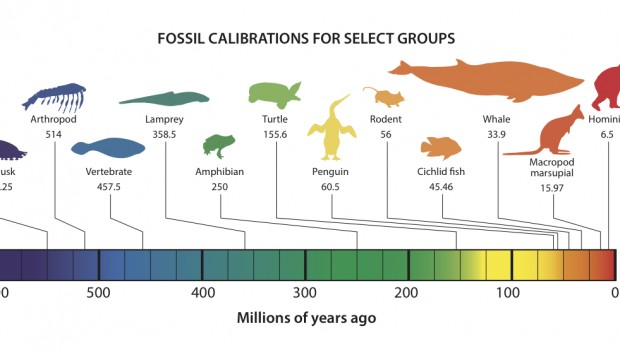Fossil Calibration Database
Last week, the Fossil Calibration Database was launched.
We spoke to Dr. Dan Ksepka, one of the leads on the project about it –“A team of over twenty paleontologists, molecular biologists, programmers, and computer scientists spent the last four years designing and testing the database and collecting data on over 120 key fossil calibrations spread across the Tree of Life to provide the initial dataset. Over time, the number of fossil calibrations in the database will grow, perhaps into the thousands.
So what are fossil calibrations? They can be thought of as anchors that allow us to convert branch length data from DNA into time estimates. Imagine two species that become reproductively isolated. As time passes, mutations occur, and their DNA accumulates differences, which are referred to as substitutions. The number of substitutions provides an estimate of the time elapsed since two species last shared a common ancestor: the divergence date.
If substitutions accumulated at a steady rate, it would be fairly easy to count them up and calculate the divergence date. However, this “molecular clock” does not tick at an even rate, and different groups of plants or animals may accumulate substitutions more rapidly or slowly due to differences in population size, reproductive strategy, longevity, and other factors.
Fossil calibrations are anchors based on fossil specimens that can be assigned to a particular branch of the Tree of Life and dated to a particular time period using geological evidence. Good fossil representatives can be used to constrain ages of certain divergences in the Tree of Life. We canthen estimate the ages of other divergences where we don’t have good fossils by using a relaxed version of the molecular clock. The basic role of fossil calibrations is to help keep the clock accurate.
Unfortunately, the calibration step of analyses has often been treated in a much less rigorous manner than other parts of the process, such as gene sequence alignment. There are many pitfalls, including fossils that get assigned to a species casually but do not hold up to close scrutiny, constant updates of age estimates as geologists refine stratigraphic columns and global timescales, shifting estimates of where key fossils belong in the Tree of Life, and many more.
We designed the Fossil Calibration Database as a solution to these challenges. Most importantly, each fossil calibration must meet five Best Practices and pass peer-review, in order to ensure every entry is as accurate as possible. The data are centralized, so a molecular biologist can search or browse for fossil calibrations useful to their study and properly credit the paleontologists who contributed the data. A tree graphic is included showing the placement of each fossil, in order to head off any confusion. And of course, it can be updated as new fossils are discovered, or age estimates from geological evidence change.
Open-access science is important to us, so everything about the database is open. All data are released under a CC0 waiver, and the contents can be downloaded.We also partnered with an open-access journal as the major pipeline for new calibrations. The Fossil Calibration Series is part of the online, peer-reviewed journal Palaeontologia Electronica and offers authors a rapid turnaround publication venue. Fossil Calibration Series papers PDFs will be linked directly from the database, so users can read the full details of new calibrations – all with no paywalls or subscription costs.”
http://www.fossilcalibrations.org


















